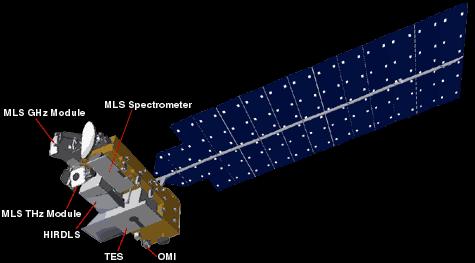Aura (original) (raw)

Home - Search - Browse - Alphabetic Index: 0- 1- 2- 3- 4- 5- 6- 7- 8- 9
A- B- C- D- E- F- G- H- I- J- K- L- M- N- O- P- Q- R- S- T- U- V- W- X- Y- Z
Aura

Aura
American earth atmosphere satellite. Earth Observing System (EOS) Aura was a NASA mission to study the Earth's ozone, air quality and climate.
Status: Operational 2004. First Launch: 2004-07-15. Last Launch: 2004-07-15. Number: 1 . Payload: 1,200 kg (2,600 lb). Gross mass: 2,967 kg (6,541 lb).
Aura was the third in a series of major Earth observing satellites to study the environment and climate change. Terra and studied the land, oceans, and the Earth's radiation budget.
Aura's chemistry measurements were also to follow up on measurements which began with NASA'S Upper Atmospheric Research Satellite and continue the record of satellite ozone data collected from the TOMS missions.
The EOS Aura satellite, instruments, launch, and science investigations were managed by NASA's Goddard Space Flight Center in Greenbelt, Maryland. The satellite was launched in July 2004 and was designed to operate for five or more years. Scientific payloads included:
- HIRDLS - High Resolution Dynamics Limb Sounder
- MLS - Microwave Limb Sounder
- OMI - Ozone Monitoring Instrument
- TES - Tropospheric Emission Spectrometer The Aura spacecraft was based on the EOS Common Spacecraft design adapted for the Aura scientific instrument payload. Built by TRW Inc. (Redondo Beach, CA), the spacecraft provided the essential services for operating the four scientific instruments including electrical power, thermal environment, field of view freedom, and pointing accuracy and stability required to obtain scientific data over the six year life of the mission.
The Aura spacecraft bus design was the same as that of NASA's Aqua mission: mechanical and electrical interfaces for accommodating the science payloads differed between the two spacecraft, but the bus subsystems, such as electrical power and attitude control, were identical, resulting in reduced cost for both design and the acquisition of hardware and software.
The spacecraft was put into a near polar, sun-synchronous orbit with a period of approximately 100 minutes. The spacecraft repeated its ground track every 16 days to provide atmospheric measurements over virtually every point on the Earth in a repeatable pattern, permitting assessment of atmospheric phenomena changes in the same geographic locations throughout the life of the mission.
Aura Specifications
- Size: Stowed - 8.8 ft h (2.70 m ) by 7.5 ft w (2.28 m ) by 22.7 ft (6.91 m )
- Deployed - 15.4 ft h (4.70 m ) by 57.0 ft w (17.37 m ) by 22.7 ft (6.91 m )
- Weight: Total - 6,542 lbs (2,967 kg)
- Spacecraft - 3,896 lbs (1,767 kg)
- Instruments - 2,646 lbs (1,200 kg)
- Power: 4,600W (End of Life)
- Telemetry: S-band
- Orbit: 438 mi (705 km) polar, sun-synchronous, 1:45 PM ascending node
- Launch Vehicle: Delta 7920
Electric System: 4.60 average kW.
More at: Aura.
Family: Atmosphere sat, Earth, Sun synchronous orbit. Country: USA. Launch Vehicles: Thor, Delta, Delta 7920-10, Delta 7920-10L. Launch Sites: Vandenberg, Vandenberg SLC2W. Agency: NASA, TRW. Bibliography: 2, 3600, 3601, 547, 6372, 12140, 12141.
Photo Gallery
 |
AuraCredit: Manufacturer Image |
|---|
 |
AuraCredit: Manufacturer Image |
|---|
2004 July 15 - . 10:02 GMT - . Launch Site: Vandenberg. Launch Complex: Vandenberg SLC2W. LV Family: Thor. Launch Vehicle: Delta 7920-10L.
- Aura - . Payload: EOS-CHEM1 / T330 (AB1200). Mass: 2,967 kg (6,541 lb). Nation: USA. Agency: NASA. Manufacturer: TRW. Class: Earth. Type: Atmosphere satellite. Spacecraft: Aura. USAF Sat Cat: 28376 . COSPAR: 2004-026A. Apogee: 694 km (431 mi). Perigee: 688 km (427 mi). Inclination: 98.20 deg. Period: 98.60 min. Atmosphere Dynamics & Chemistry. Delayed from January 29, February 6, March 19, June 17, 19 and 26, July 8, 10, 11, 13 and 14..
Home - Search - Browse - Alphabetic Index: 0- 1- 2- 3- 4- 5- 6- 7- 8- 9
A- B- C- D- E- F- G- H- I- J- K- L- M- N- O- P- Q- R- S- T- U- V- W- X- Y- Z
© 1997-2019 Mark Wade - Contact
© / Conditions for Use